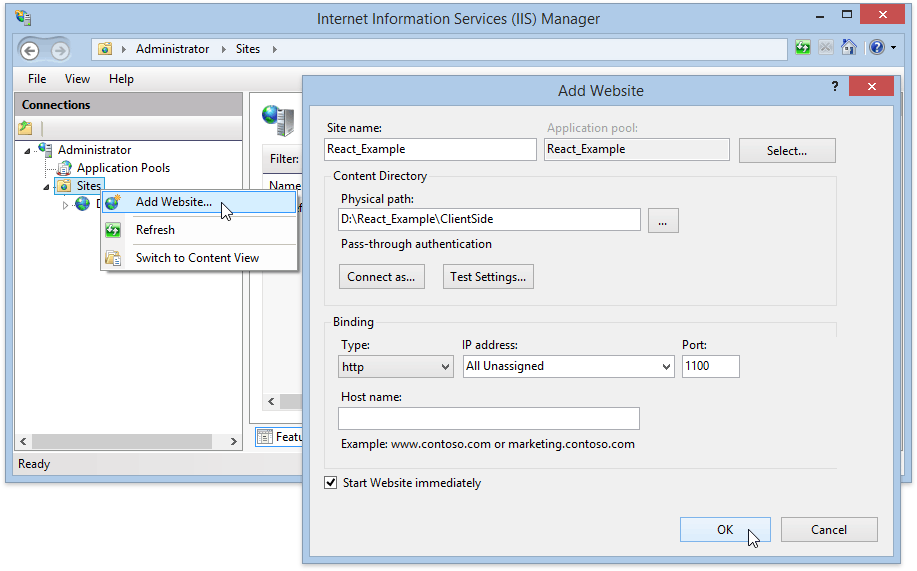Document Viewer Integration in React
- 3 minutes to read
Tip
Online Example: How to use the Web Document Viewer in JavaScript with React
You can use the HTML5 Document Viewer in JavaScript with React based on the server-side model. You should create two projects: a server (backend) project and a client (frontend) part that includes all the necessary styles, scripts, and HTML-templates.
Important
Perform the steps from one of the following topics to prepare a backend application:
This document describes how to configure and host the client part:
- Create a new folder to store all the files related to the client-side functionality (for instance, name it ClientSide).
Use Bower to download all the necessary client resources. Add the bower.json file in the created folder and add the following code to this file:
{ "name": "html5-document-viewer-example-react", "dependencies": { "xtrareportsjs": "~18.2.3", "react": "latest", "babel": "latest" } }Ensure that you correctly specify the required reporting controls’ version.
Open the console, navigate to your application folder and run the following command:
bower installYou can find all the libraries in the bower_components folder after installation is completed.
Create a View file in the root folder (the index.html file in this example) and add links to Bower resources to the head section.
<!DOCTYPE html> <html> <head> <title></title> <link href="~/bower_components/devextreme/css/dx.common.css" rel="stylesheet" /> <link href="~/bower_components/devextreme/css/dx.light.css" rel="stylesheet" /> <script src="~/bower_components/jquery/dist/jquery.js"></script> <script src="~/bower_components/knockout/dist/knockout.js"></script> <script src="~/bower_components/devextreme/js/dx.all.js"></script> <script src="~/bower_components/jquery-ui/jquery-ui.js"></script> <link href="~/bower_components/jquery-ui/themes/base/jquery-ui.min.css" rel="stylesheet" /> <link href="~/bower_components/xtrareportsjs/css/dx-analytics.common.min.css" rel="stylesheet" /> <link href="~/bower_components/xtrareportsjs/css/dx-analytics.light.min.css" rel="stylesheet" /> <link href="~/bower_components/xtrareportsjs/css/dx-webdocumentviewer.min.css" rel="stylesheet" /> <script src="~/bower_components/xtrareportsjs/js/dx-analytics-core.min.js"></script> <script src="~/bower_components/xtrareportsjs/js/dx-webdocumentviewer.min.js"></script> <script src="~/bower_components/react/react.development.js"></script> <script src="~/bower_components/react/react-dom.development.js"></script> <script src="~/bower_components/babel/browser.js"></script> </head> ... </html>Make sure that you meet all the requirements to deploy the control on the client. Refer to Document Viewer Requirements and Limitations for a complete client resource list.
Note that this sample uses a script with a predefined localization dictionary.
Add a JSX file (example.jsx) to provide data to the View.
Create the ReportViewer and Root classes that extend the base React.Component class as shown below. Use the dxReportViewer binding to render the Document Viewer element.
"use strict" const host = 'http://localhost:54114/'; class ReportViewer extends React.Component { constructor(props) { super(props); this.reportUrl = ko.observable(props.reportUrl); this.requestOptions = { host, // Use this line if you use an ASP.NET MVC backend invokeAction: "WebDocumentViewer/Invoke" // Uncomment this line if you use an ASP.NET Core backend // invokeAction: "DXXRDV" }; } render() { return (<div ref="viewer" data-bind="dxReportViewer: $data"></div>); } componentWillReceiveProps(newProps) { this.reportUrl(newProps.reportUrl); } componentDidMount() { ko.applyBindings({ reportUrl: this.reportUrl, requestOptions: this.requestOptions }, this.refs.viewer); } componentWillUnmount() { ko.cleanNode(this.refs.viewer); } } class Root extends React.Component { constructor(props) { super(props); this.state = { value: "Products", reports: [] }; } render() { return (<div style = {{width: "100%", height: "1000px"}}> <ReportViewer reportUrl={this.state.value} /> </div>); } } ReactDOM.render(<Root />, document.getElementById("viewerhost"))Link the file created at the previous step in the index.html file:
<!DOCTYPE html> <html> ... <body> <div id="viewerhost"></div> <script type="text/babel" src="example.jsx"></script> </body> </html>Host your client-side part on the web server.
For instance, start the Internet Information Services (IIS) Manager, right-click the Sites item in the Connections section and select Add Website. In the invoked dialog, specify the site name, the path to the folder with the client-side functionality and the website’s IP address.

- For this example to work correctly, you should first run a backend project in Visual Studio before running the client part.